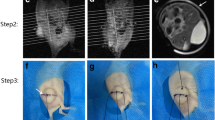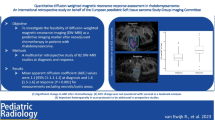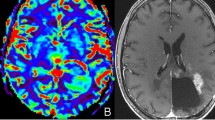Abstract
We aimed to examine different intratumoral changes after single-dose and fractionated radiotherapy, using diffusion-weighted (DW) and dynamic contrast-enhanced (DCE) MRI in a rat rhabdomyosarcoma model. Four WAG/Rij rats with rhabdomyosarcomas in the flanks received single-dose radiotherapy of 8 Gy, and four others underwent fractionated radiotherapy (five times 3 Gy). In rats receiving single-dose radiotherapy, a significant perfusion decrease was found in the first 2 days post-treatment, with slow recuperation afterwards. No substantial diffusion changes could be seen; tumor growth delay was 12 days. The rats undergoing fractionated radiotherapy showed a similar perfusion decrease early after the treatment. However, a very strong increase in apparent diffusion coefficient occurred in the first 10 days; growth delay was 18 days. DW-MRI and DCE-MRI can be used to show early tumoral changes induced by radiotherapy. Single-dose and fractionated radiotherapy induce an immediate perfusion effect, while the latter induces more intratumoral necrosis.






Similar content being viewed by others
References
Senan S, Smit EF (2007) Design of clinical trials of radiation combined with antiangiogenic therapy. Oncologist 12:465–477
Hartsell WF, Scott CB, Bruner DW et al (2005) Randomized trial of short- versus long-course radiotherapy for palliation of painful bone metastases. J Natl Cancer Inst 97:798–804
Onimaru R, Fujino M, Yamazaki K et al (2007) Steep dose–response relationship for stage I non-small-cell lung cancer using hypofractionated high-dose irradiation by real-time tumor-tracking radiotherapy. Int J Radiat Oncol Biol Phys 70:374–381
Stroobants S, Goeminne J, Seegers M et al (2003) 18FDG-positron emission tomography for the early prediction of response in advanced soft tissue sarcoma treated with imatinib mesylate (Glivec). Eur J Cancer 39:2012–2020
Grégoire V, Bol A, Geets X et al (2006) Is PET-based treatment planning the new standard in modern radiotherapy? The head and neck paradigm. Semin Radiat Oncol 16:232–238
Le Bihan D (1995) Molecular diffusion, tissue microdynamics and microstructure. NMR Biomed 8:375–386
Padhani AR, Husband JE (2001) Dynamic contrast-enhanced MRI studies in oncology with an emphasis on quantification, validation and human studies. Clin Radiol 56:607–620
Thoeny HC, De Keyzer F, Chen F et al (2005) Diffusion-weighted MR imaging in monitoring the effect of a vascular targeting agent on rhabdomyosarcoma in rats. Radiology 234:756–764
Mayr NA, Magnotta VA, Ehrhardt JC et al (1996) Usefulness of tumor volumetry by magnetic resonance imaging in assessing response to radiation therapy in carcinoma of the uterine cervix. Int J Radiat Oncol Biol Phys 35:915–924
Allen SD, Padhani AR, Dzik-Jurasz AS et al (2007) Rectal carcinoma: MRI with histologic correlation before and after chemoradiation therapy. Am J Radiol 188:442–451
Hatano K, Sekiya Y, Araki H et al (1999) Evaluation of the therapeutic effect of radiotherapy on cervical cancer using magnetic resonance imaging. Int J Radiat Oncol Biol Phys 45:639–644
van de Bunt L, van der Heide UA, Ketelaars M et al (2006) Conventional, conformal and intensity-modulated radiation therapy treatment planning of external beam radiotherapy for cervical cancer: the impact of tumor regression. Int J Radiat Oncol Biol Phys 64:189–196
Thoeny HC, De Keyzer F, Chen F et al (2005) Diffusion-weighted magnetic resonance imaging allows noninvasive in vivo monitoring of the effects of combretastatin A-4 phosphate after repeated administration. Neoplasia 7:779–787
Seierstad T, Folkvord S, Roe K et al (2007) Early changes in apparent diffusion coefficient predict the quantitative antitumoral activity of capecitabine, oxaliplatin, and irradiation in HT29 xenografts in athymic nude mice. Neoplasia 9:392–400
Chenevert TL, McKeever PE, Ross BD (1997) Monitoring of early response of experimental brain tumors to therapy using diffusion MRI. Clin Cancer Res 3:1457–1466
Stegman LD, Rehemtulla A, Hamstra DA et al (2000) Diffusion MRI detects early events in the response of a glioma model to the yeast cytosine deaminase gene therapy strategy. Gene Ther 7:1005–1010
Mardor Y, Pfeffer R, Spiegelmann R (2003) Early detection of response to radiation therapy in patients with brain malignancies using conventional and high b-value diffusion-weighted magnetic resonance imaging. J Clin Oncol 21:1094–1100
Tomura N, Narita K, Izumi J et al (2006) Diffusion changes in a tumor and peritumoral tissue after stereotactic irradiation for brain tumors: possible prediction of treatment response. J Comput Assist Tomogr 30:496–500
Thoeny HC, De Keyzer F, Vandecaveye V et al (2005) Effect of vascular targeting agent in rat tumor model: dynamic contrast-enhanced versus diffusion-weighted MR imaging. Radiology 237:492–499
Ceelen W, Smeets P, Backes W et al (2006) Noninvasive monitoring of radiotherapy-induced microvascular changes using dynamic contrast enhanced magnetic resonance imaging (DCE-MRI) in a colorectal tumor model. Int J Radiat Oncol Biol Phys 64:1188–1196
Kobayashi H, Reijnders K, English S et al (2004) Application of a macromolecular contrast agent for detection of alterations of tumor vessel permeability induced by radiation. Clin Cancer Res 10:7712–7720
Horsman MR, Nielsen T, Ostergaard L et al (2006) Radiation administered as a large single dose or in a fractionated schedule: role of the tumour vasculature as a target for influencing response. Acta Oncol 45:876–880
Acknowledgments
This work has been partly financially supported by the research grant “Prof. Em. A. L. Baert, Siemens Medical Solutions”.
Author information
Authors and Affiliations
Corresponding author
Rights and permissions
About this article
Cite this article
De Keyzer, F., Vandecaveye, V., Thoeny, H. et al. Dynamic contrast-enhanced and diffusion-weighted MRI for early detection of tumoral changes in single-dose and fractionated radiotherapy: evaluation in a rat rhabdomyosarcoma model. Eur Radiol 19, 2663–2671 (2009). https://doi.org/10.1007/s00330-009-1451-1
Received:
Accepted:
Published:
Issue Date:
DOI: https://doi.org/10.1007/s00330-009-1451-1




